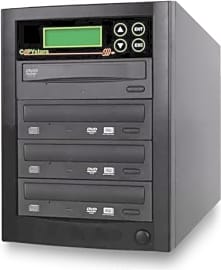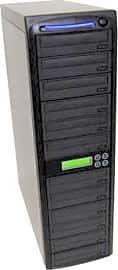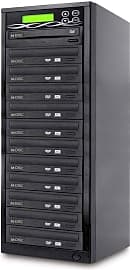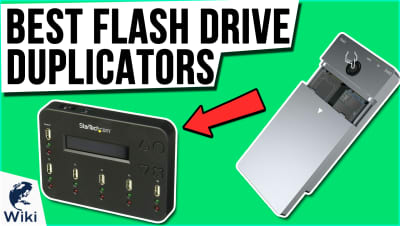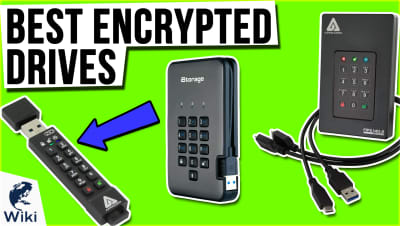The 6 Best DVD Duplicators

This wiki has been updated 40 times since it was first published in April of 2015. Whether you run a business requiring the archiving of large amounts of data or you simply want to preserve personal files, HD videos, and music for long-term enjoyment, one of these DVD duplicators can help get the job done. Many of these copiers work as standalone units and offer fast burning speeds, automatic disc recognition, and a wide range of compatibility with CD, DVD, and Blu-ray media. When users buy our independently chosen editorial choices, we may earn commissions to help fund the Wiki.
Editor's Notes
August 06, 2021:
Given that DVDs aren't any more popular than they were the last time we revisited this Wiki, it's no surprise that there aren't any new options to consider. The Copystars 1TB-6 remains our top choice because of its extremely convenient USB connectivity, which sets it apart from the pack. If you need to pump out a huge amount of copies, on the other hand, the Produplicator 10DVD is the industrial-grade choice for you. Its daisy chaining ability lets you join as many units as you need for copying your sensitive data.
April 16, 2020:
These are pretty specialized devices. The Copystars 1TB-6 stands out as one of the most convenient because it offers PC-based ISO burning and doesn't require an actual disc be placed in its source drive. The Copystars SATA is a bit less convenient because most versions lack that function, but it is available in a range of capacities to suit your needs. Speaking of capacity, if you need that above all else and can afford a huge investment, the Produplicator PDE20X15 is worth a look due to its daisy-chaining capabilities.
On the other hand, if you specifically don't want to spend much, consider the Acumen 1-to-5, which is one of the most reasonably priced. The Produplicator PDE20X15 and Produplicator AMA-BD-11 are both designed for use with CDs, DVDs, and Blu-ray discs, and while they do allow for high-density archival, they will set you back a pretty penny compared to the DVD-only models.
If you need something to rip an image of a DVD to your PC, take a look at our selection of DVD drives, all of which are also compatible with CDs, and some of which work with Blu-rays.
Special Honors
MediaXpress Short Run DVD Production As a professional service, you can be certain that the results from MediaXpress will be consistent and error-free. One of the convenient parts of their system is the ability to design menus and packaging on your own and submit the plans to be printed and assembled at their factory. mediaxpress.net
DiscMakers Blu-Ray Duplication This is an especially useful service if you've produce your own films in high definition and want to distribute physical copies. Once your order is received, they'll be able to mail you your new discs in as little as 5 days. discmakers.com
Towers Of Efficiency
Unlike duplication, there is no pre-existing source media involved before the replication process begins.
With the growing popularity of file streaming, one might believe that physical disc media is going the way of the dinosaur as an archaic means of data storage. After all, a person no longer has to go to a video store to rent or buy a movie. They can simply stream high-definition content using digital video recording services to capture the content they wish to watch. That said, there is still a place for physical media (e.g. a CD or DVD movie). In fact, some professionals still depend on this technology to share data. For example, if you are a video producer sharing your content with multiple networks or fellow professionals and you don't want to risk losing your files in cyberspace, then a DVD duplicator can be a wise investment.
So what exactly is a DVD duplicator, anyway? Let's break it down to something simple. If your computer or laptop is equipped with an optical disc writer, then you already have the ability to duplicate video in some form. However, chances are your optical drive has the capacity to hold only a single disc at a time. When we discuss the DVD duplicator, we are referring to a dedicated duplication tower that integrates several stacked DVD optical drives into its design, meaning that it can produce many copies of a single DVD more quickly than an ordinary optical drive inside a laptop. The device comes in one of two major categories: standalone and computer-based. A standalone duplicator's ability to function independently without requiring additional software to operate sets it apart from a computer equipped with a single DVD writer.
The standalone duplicator tower features a built-in controller responsible for sending commands to each of its individual burners. While its available memory and internal operating system determine the quality of the discs it copies, the standalone duplicator is usually equipped with several operating keys and buttons that allow it to perform a variety of tasks. The first task is pre-scanning, during which a master disc (typically placed in the tower's topmost optical drive) is checked for dirt, scratches, copy protection, and disc format. This source disc is then used to copy data to all of the other target discs in the tower. The second task includes simulated copy tests to ensure error-free duplication. Thirdly is the device's ability to skip read errors it encounters during the actual copying process in case the pre-scanning step missed something. The fourth task includes a digital counter on the tower's display, letting you know how many discs have been duplicated as well as how many are remaining to be copied. The fifth and final task is a comparison to ensure that all target discs are identical to the source media.
Some standalone duplicators have their own hard disk drives that allow you to copy the source material more quickly from that location rather than from a source disc. This will provide additional space to make use of more of the burner drives. If you've tried to make a custom DVD in the past, you may recall having to purchase and install some type of DVD burning software that could communicate with your computer's operating system and accept commands. The standalone duplicator essentially removes your computer from the equation with a primary focus on copying source disc media using its own embedded software.
Computer-based DVD duplicators will author a disc image directly from a laptop or desktop computer, eliminating the need to transfer the source media to the duplicator tower. Computer-based duplicators often include feature-rich software that allows you to set up multiple jobs for burning, which means you can drop in a stack of discs and earmark certain portions of the spindle for different duplication projects.
In order to fully understand duplication, we must also briefly touch on the concept of DVD replication because there is a difference between the two processes. As we've already learned that duplication involves extracting data from an existing source disc for burning to several blank target discs, DVD replication occurs during the actual manufacturing process. This replication process is also referred to as molding or pressing, as a glass master is used to develop a stamper. The stamper is then loaded into an injection molding machine that creates the DVD replicas. Unlike duplication, there is no pre-existing source media involved before the replication process begins. Replicated DVDs are similar to those you might find or buy in a video store or online.
How To Make Your Decision
There are several things to keep in mind when investing in a DVD duplicator. Firstly, one must determine the types of discs they will need to use. Many duplicators accommodate both CD and DVD media, which comes in handy when you're a music producer and you need to burn multiple copies of your albums to several discs at once. If you plan to duplicate high-definition content, then a Blu-ray duplicator might also be an asset due to the disc format's high capacity and the fact that the tower is backwards compatible with other disc media, including DVD.
Finally, if duplication speed is a major consideration for your projects, then definitely consider a standalone unit equipped with its own hard disk drive.
Secondly, consider your volume and how many target burning drives you think you'll need. Duplicator towers come with anywhere from one to fifteen available target drives, all depending on your needs and how much you think you'll be duplicating at the same time.
Thirdly, consider both the drive speed of your duplicator, as well as the write speed available on the discs you choose. One must be aware that fast components will be more expensive, so weighing one's budget against what seems practical for business needs will matter.
Finally, if duplication speed is a major consideration for your projects, then definitely consider a standalone unit equipped with its own hard disk drive. Not only will this free up additional space, but it also provides for faster duplication using a dedicated drive that is separate from the source and target disc drives located on the tower.
A Brief History Of DVD Duplicators
While the invention of the DVD duplicator is not attributed to a single individual, the optical disc format has a long history dating back to the late 1950s. American inventors David Paul Gregg and James Russell first developed optical recording technology in 1958. Gregg was inspired to create the optical disc while working at California electronics company Westrex. Gregg's 1961 patent was referred to as the Videodisk. The LaserDisc format later developed in the United States by 1978, using very large rotating optical discs. Unfortunately, the high costs of these discs and players did not foster mass consumer adoption.
The video CD format became popular in the early 1990's as the main source of digitally-encoded film distribution. At the same time, both the Multimedia Compact Disc (supported by Philips and Sony) and Super Density disc formats gained their own traction. By early 1995, the Multimedia Compact Disc nomenclature was dropped in favor of the Digital Video Disc.
Three qualities the DVD format had in abundance included ample storage capacity, full-motion video and sound, and lower costs. This ultimately paved the way for the development of specifically-dedicated towers that could mass-duplicate source DVD media for storage, sharing, and production purposes.


